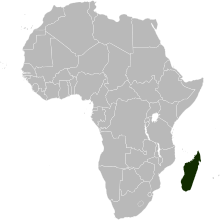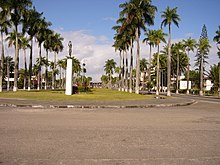The Madagascar Portal
Madagascar, officially the Republic of Madagascar, is an island country comprising the island of Madagascar and numerous smaller peripheral islands. Lying off the southeastern coast of Africa, it is the world's fourth largest island, the second-largest island country and the 46th largest country in the world. Its capital and largest city is Antananarivo. Following the prehistoric breakup of the supercontinent Gondwana, Madagascar split from Africa during the Early Jurassic, around 180 million years ago, and split from the Indian subcontinent around 90 million years ago, allowing native plants and animals to evolve in relative isolation; consequently, it is a biodiversity hotspot and one of the world's 17 megadiverse countries, with over 90% of wildlife being endemic. The island has a subtropical to tropical maritime climate. Madagascar was first settled during or before the mid-first millennium AD by Austronesian peoples, presumably arriving on outrigger canoes from present-day Indonesia. These were joined around the ninth century AD by Bantu migrants crossing the Mozambique Channel from East Africa. Other groups continued to settle on Madagascar over time, each one making lasting contributions to Malagasy cultural life. Consequently, there are 18 or more classified peoples of Madagascar, the most numerous being the Merina of the central highlands. Until the late 18th century, the island of Madagascar was ruled by a fragmented assortment of shifting sociopolitical alliances. Beginning in the early 19th century, most of it was united and ruled as the Kingdom of Madagascar by a series of Merina nobles. The monarchy was ended in 1897 by the annexation by France, from which Madagascar gained independence in 1960. The country has since undergone four major constitutional periods, termed republics, and has been governed as a constitutional democracy since 1992. Following a political crisis and military coup in 2009, Madagascar underwent a protracted transition towards its fourth and current republic, with constitutional governance being restored in January 2014. (Full article...) This is a Featured article, which represents some of the best content on English Wikipedia..
Lavanify is a mammalian genus from the late Cretaceous (probably Maastrichtian, about 71 to 66 million years ago) of Madagascar. The only species, L. miolaka, is known from two isolated teeth, one of which is damaged. The teeth were collected in 1995–1996 and described in 1997. The animal is classified as a member of Gondwanatheria, an enigmatic extinct group with unclear phylogenetic relationships, and within Gondwanatheria as a member of the family Sudamericidae. Lavanify is most closely related to the Indian Bharattherium; the South American Sudamerica and Gondwanatherium are more distantly related. Gondwanatheres probably ate hard plant material. Lavanify had high-crowned, curved teeth. One of the two teeth is 11.2 mm high and shows a deep furrow and, is centered laterally in the crown, a V-shaped area that consists of dentine. The other, damaged, tooth is 9.8 mm high and has at least one deep cavity (infundibulum). Characters shared by the teeth of Lavanify and Bharattherium include the presence of an infundibulum and a furrow; they both also have large, continuous bands of matrix (unbundled hydroxyapatite crystals) between the prisms (bundles of hydroxyapatite crystals) of the enamel, and perikymata—wave-like ridges and grooves in the enamel surface. (Full article...)Selected article -
Toamasina (Malagasy pronunciation: [toˈmasinə̥]), meaning "like salt" or "salty", unofficially and in French Tamatave, is the capital of the Atsinanana region on the east coast of Madagascar on the Indian Ocean. The city is the chief seaport of the country, situated 215 km (134 mi) northeast of its capital and biggest city Antananarivo. In 2018 Toamasina had a population of 325,857. (Full article...) This is a Good article, an article that meets a core set of high editorial standards.
 The Madagascar Plan (German: Madagaskarplan) was a plan proposed by the Nazi German government to forcibly relocate the Jewish population of Europe to the island of Madagascar. Franz Rademacher, head of the Jewish Department of the German Foreign Office, proposed the idea in June 1940, shortly before the Fall of France. The proposal called for the handing over of control of Madagascar, then a French colony, to Germany as part of the eventual peace terms. The idea of re-settling Polish Jews to Madagascar was investigated by the Polish government in 1937, but the task force sent to evaluate the island's potential determined that only 5,000 to 7,000 families could be accommodated, or even as few as 500 families by some estimates. As the efforts by the Nazis to encourage the emigration of the Jewish population of Germany before World War II were only partially successful, the idea of deporting Jews to Madagascar was revived by the Nazi government in 1940. (Full article...)General images -The following are images from various Madagascar-related articles on Wikipedia.
Selected pictureAssociated WikimediaThe following Wikimedia Foundation sister projects provide more on this subject:
Discover Wikipedia using portals | |||











































































